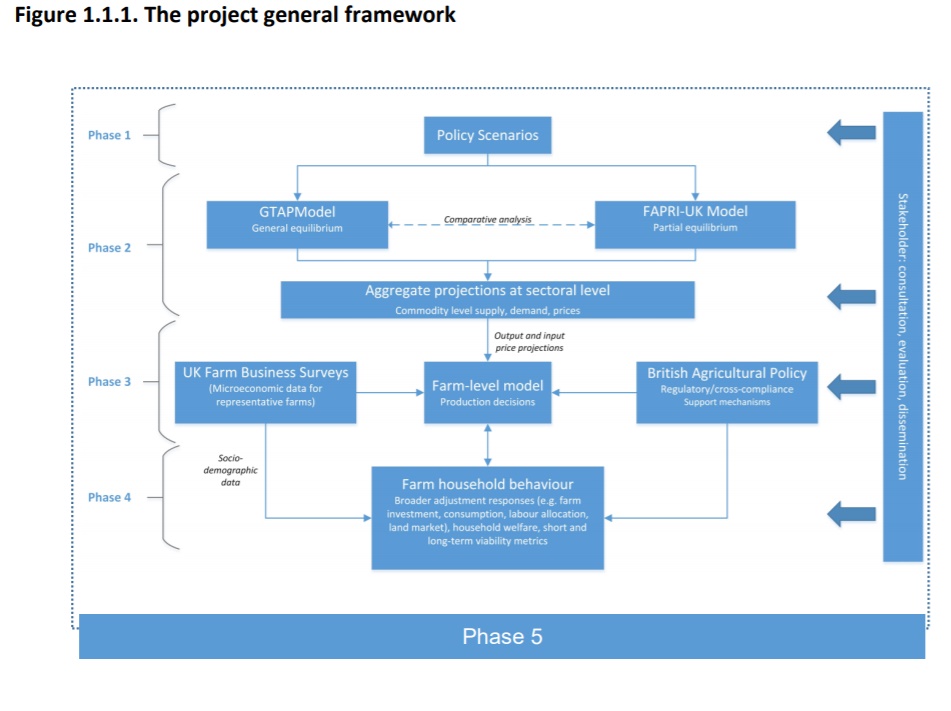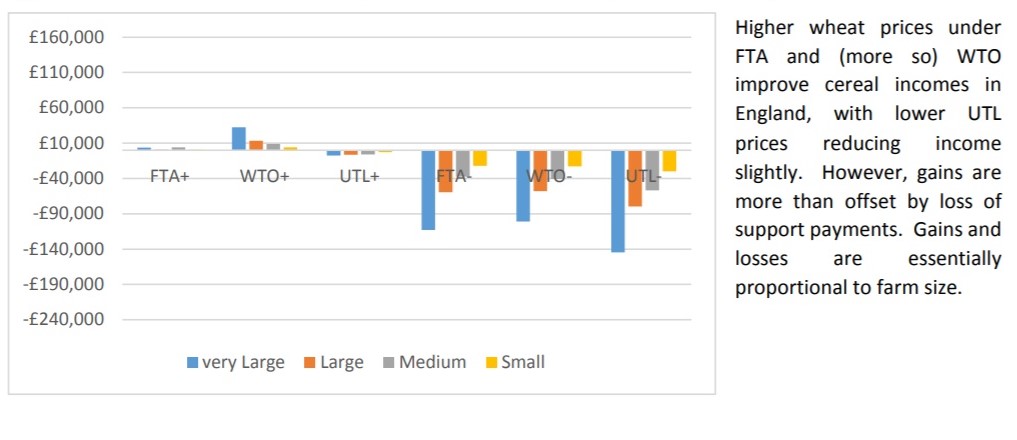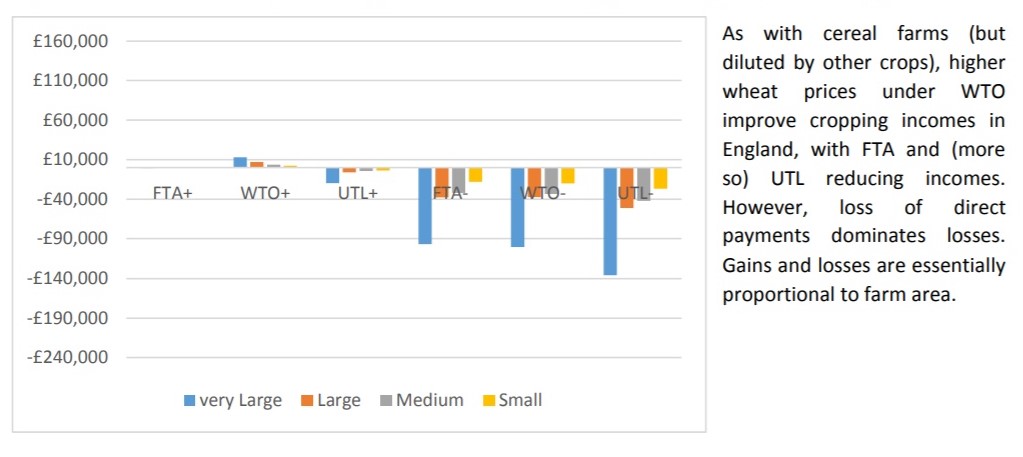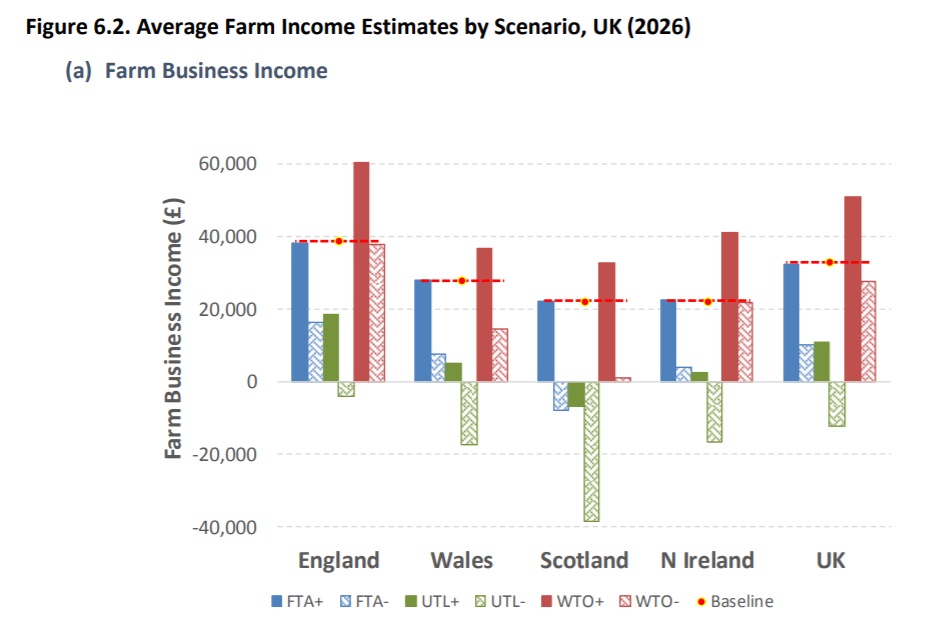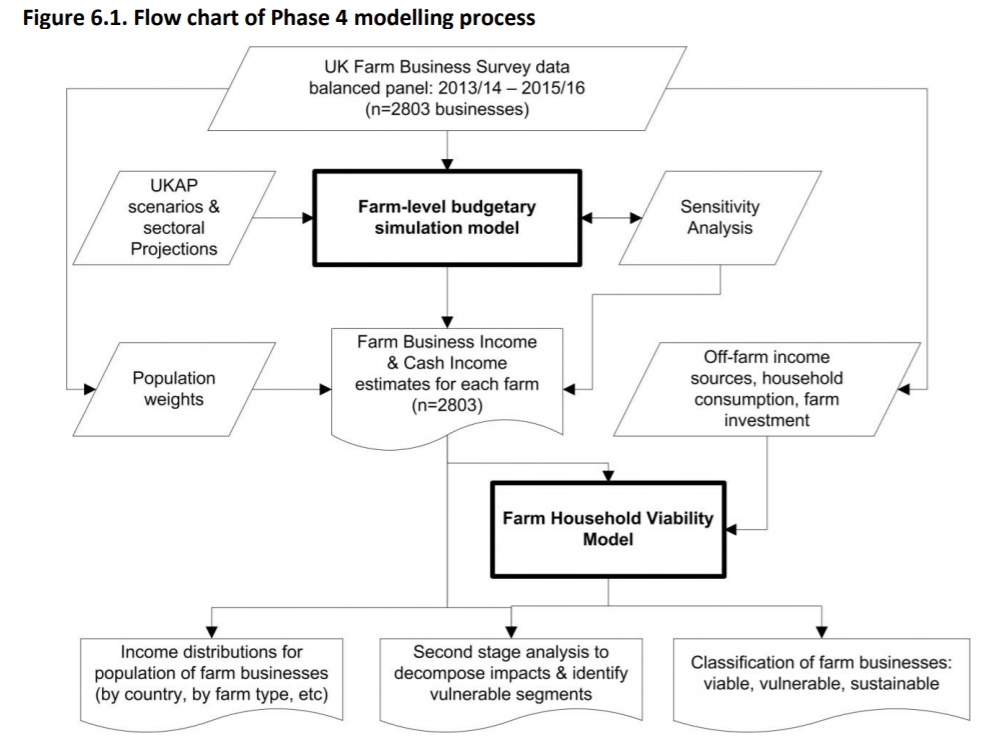A Problem-Solving Solution
With the rapid growth of population, increased scarcity of resources, as well as dramatic climate changes, the agricultural sector is currently facing a number of challenges. These are essential issues to consider since they might jeopardize the natural resources, ecosystems, and livelihoods in general. The impacts on agronomics may lead to economic and social outcomes, and affect nutrition security within its core dimensions, including “food accessibility, food availability, food utilization, and food systems’ stability” (Ramasamy et al., 2017, p. 17). The agricultural sector is considered as one of the most crucial areas that require many varieties with multifunctional facilities to address the challenges that farmers face concerning the enhanced crop yield. Objects and sensors with access to the Internet can be supplied anywhere for information gathering on humidity levels and crop health.
Therefore, data can be available to farmers via tablets and smartphones due to manual and automated options. Thompson (2019) states that the application of drones (UAVs) in agriculture, specifically in the United Kingdom, can promote the enhancement of crops and reduce the usage of pesticides. According to Puri, Nayyar & Raja (2017, p. 510), agriculture drones are beneficial for “agriculture farm analysis, time-saving, higher agricultural yield, GIS mapping integration, and imaging of crop health Status.” Drones are high-class credible devices that fly in the sky and, thus, are useful for farmers as they can inspect the general situation on the farm at the beginning of each harvest year. Furthermore, drones produce 3D maps for soil analysis, which is useful for farmers to take good care during seed plowing. Such a soil and field investigation with the aid of drones also supplies data that is useful for irrigation and controlling the nitrogen level of fields for the improved results of crop growing.
With that said, the use of agricultural drones is a time-saving approach since farmers have a significant amount of hectares of farmland. Hence, it is a complex task to inspect every nook and corner of the cultivated land every so often. However, drones can carry out this task without any problems, which implies that farmers are enabled to perform regular air monitoring of the field to observe the condition of their crops periodically. In terms of GIS mapping, it is a highly useful approach in the agriculture industry that promotes managing “resources, yield increase, input cost management, better business management and more” (Puri et al., 2017, p. 510). The farmers can outline field borders for precise flight patterns due to the GIS mapping integrated with drones.
Moreover, drones facilitate the high-accuracy application of pesticides, water, and use of fertilizers, which can increase the yield and the general quality of care that can be generated. Ultimately, drones are useful for crop health imaging with the help of Infrared, NVDI, and multispectral sensors, which improve the track of crop health, transpiration indicators, and sunlight absorption rates. Based on the estimation of Grand View Research, the commercial scale for agricultural drones is expected to “exceed USD 3770 million by 2024” (Patel, 2018, para. 15). However, the drone system enforcement is currently facing strict British laws due to its potential threat to life and ethical issues.
Analysis of the External Macro Environment of Agriculture
The agricultural business environment is highly significant to the economy of the United Kingdom. As analyzed by the Future Farming and Environment Evidence Compendium (CITE), agriculture contributes less than 0.5% to the British economy, however, it provides half of the total amount of the food consumed. In addition, the agricultural sector of the UK recruits half a million people, which is 1.5% of the total workforce that is primarily engaged in business ownership or management. It is also crucial for the food and drink industry since it supplied £ 112bn to the economy as of 2016.
More specifically, farmers and landholders manage 72% of the UK’s land, which enables the country to preserve and protect the natural environment and provide the highest standards of flora and fauna health. It is important to consider the annual indicators of farming income of different years to fully evaluate agriculture’s performance and contribution to the economy.
In terms of changes in the external environment, one should consider the political, economic, social, technological, legislative, and environmental changes, which is known as the PESTLE analysis (Table 1). A PESTEL analysis is a tool applied for the examination of the external marketing environment factors that influence a specific organization or a business environment. According to the PESTLE analysis report of the UK, the agricultural sector decreased by a mean rate of 2.67% during 2002-14, with agrarian output reaching GBP9.56 billion ($15.51 billion) in 2014 (MarketLine, 2015).
Agriculture in the United Kingdom is a labor-intensive and highly mechanized sector, which produces 60% of nutrition needs with under 1.6% of the workforce. Agriculture in the UK is a highly technological industry, which engages only 1.4% of the population. This geographical region has a high population density and a comparative lack of land. With that said, only a third part of the gross output is involved in arable farming.
Political Landscape
The United Kingdom is one of the most prosperous and leading nations in the world that plays a fundamental role in the global scene. The UK is part of five permanent members of the UN Security Council, one of the founding members of the North Atlantic Treaty Organization, and a member of the G8. However, it had a conservative approach concerning European integration, which resulted in the withdrawal from the European Union in 2020, known as Brexit. Therefore, there are several critical aspects within the political sphere concerning British agriculture, such as the impact of Brexit, the introduction of the Sugar Tax in the UK, and British drone laws.
The Brexit framework indicates the reconsideration of the UK agricultural policy (UKAP), which is currently defined by the EU via the Common Agricultural Policy (CAP). It is also strongly complicated by environmental and rural development measures (Pillar 2 of the CAP). To be more specific, Brexit implies the suspension of further British contributions to or revenue from the budget of the European Union.
The UK farmers are currently provided with direct payments under both “entitlement” and “voluntary” schemes that are based on offsetting farmers for reducing price support. Hubbard et al. (2019, p. 32) suggest two domestic policy scenarios, such as “direct payments retained as currently under the CAP and “a gradual elimination of direct payments over a five-year period (2020-2025).” The potential options for the UK and devolved administrations within the agricultural policy should be considered in terms of the trade relationships and any associated coordination of product standards that the country implements after Brexit.
Brexit is considered to have a negative influence on UK Gross Domestic Product (GDP) and real per capita incomes. However, such power is alleviated by the removal of UK-RoW tariff barriers, which produces enhanced UK real incomes related to cheaper UK access to RoW imports and increased economic capacities to British exporters from lower-cost access to RoW markets. From the macroeconomic perspective, the impacts that arise from different possible scenarios are relatively small. This can be explained by the average tariffs in the overall economy between the UK and EU, as well as the supposed increases in trade cost that are moderate for the predominant part of UK economic activities. In case of emergence of larger tariffs or trade cost shocks, these effects are usually limited to agri-food industries that represent only a small share of the UK GDP.
With that said, Brexit, together with the management of UK agricultural policies, provides principal challenges to the policy-making procedures and to the research environment responsible for producing the necessary evidence as a groundwork for sustainable strategies. With regard to the drone laws, they are becoming more stringent in the United Kingdom. Such a government’s approach was caused by the reported sightings of a drone in the London-Gatwick airspace. The airport was forced to cancel hundreds of flights. As a result, the British government responded by outlawing the drones to fly above 400 feet, or within 5 kilometres of an airport. This innovation in the drones standards directly affects the farmers who live near the airport area.
In addition, the Sugar Tax that became to operate in the United Kingdom in April 2018, directly relates to the manufacturers of sugary soft drinks. It is targeted at encouraging these manufacturers to lower the amount of sugar in their products and promoting customers to choose healthier options. Turner (2018, para. 2) believes that the Sugar Tax is “a positive step towards tackling the obesogenic environment.” The food industry and farming policy are both closely intertwined with human health and the obesity crisis.
The Common Agricultural Policy (CAP) that engages in the food market to support the manufacturing of certain foods, including sugar, regulates the prices on food in the UK. The healthier products proved to be typically more expensive than less healthy foods, which resulted in inequality of access to a healthy diet. The country’s exit from the European Union as well marked the exit from the CAP. Hence, British food and farming policy can be significantly reassessed to deal with the most stressing concerns.
Economic Landscape
The economic challenges in the British farming industry imply the effect of the macro factors and tax policies. In terms of the economic landscape, the S&P reduced its perspective on Britain’s AAA credit rating from stable to negative in June 2015. It was based upon the government’s position on holding the referendum on the UK’s membership to Eurozone in 2017. Moreover, the UK preserves persistent current account deficits since the 1990s (MarketLine, 2015). According to IMF, the current account deficit as of 2013 stood at 4.48% of GDP.
Considering the country’s GDP trends, the estimated nominal GDP of the United Kingdom in 2019 was 2.744 trillion US dollars. As a result, the country’s economy takes the 6th position on the international scene. Furthermore, the success of the British economy is a result of its diversity that contributes to an “equal opportunity for all the enterprises to grow and prosper” (Ali, 2020, para. 8). This opportunity can be enhanced in a case when such business adds values in the lives of consumers, and there is a dynamic demand in the market.
Due to densely populated territory of the United Kingdom and relative lack of land, only about a third of gross output is devoted to arable crops, while the rest is devoted to livestock. A considerable increase in productivity growth in the period prior to the financial crisis did not manage to impact the overall low level of productivity in the UK as compared to the US, France and Germany.
Such instability can be explained by structural factors, including skill gap and management quality. The lack of qualified personnel is dependent on the percentage of university-educated people and the school leavers. Other factors, involving “poor infrastructure, the proficiency level of the workforce, weak export performance, public sector inefficiencies, and the end of a product innovation cycle” also influence the productivity (MarketLine, 2015, p. 19). Also, inadequate management methods emerge from the prevalence of family-owned business that promotes the low level of overall productivity in contrast to the best performing OECD countries.
The reduced productivity in the services sectors, such as public sector and the steady deterioration in traditional fields of high-tech manufacturing over the past ten years also facilitated the productivity drop in the UK. However, the British government developed several critical steps to foster productivity levels and competitiveness of UK business that directly depend on their effective implementation. Concerning the issue of diverse culture in the United Kingdom, the country’s economy draws the attention of the majority of people globally, since it provides a space to develop a good quality of life.
As a result, many private investors and companies invest their resources and capital in a variety of areas, including real estate, science, technology, food, clothing, grocery, entertainment, and sports. The corporate tax rate for companies in the UK is now 19%. In 2016, the British government claimed to lower the tax rate to 18% by the end of 2020, which might attract more investors. It is also important to mention the impact of the unemployment rate, which was approximately 3.8% at the beginning of this year. Therefore, a per capita of the country is higher since everyone is contributing one’s share in the economy.
Social Landscape
The resident population of the United Kingdom is, to a large extent, content with a standard of living compared to other developed countries. Longstanding economic progress promoted the development of robust social infrastructure with the best ranking education and healthcare delivery systems worldwide. The government was intended to alleviate income inequality and eliminate child poverty by 2020 (Marketline, 2015). According to Agriculture Bill (2018), nearly 70% of the land was managed through farming and 10% through forestry in 2017.
The land management approach can secure and enhance the supply of public goods and other environmental outcomes with social and economic benefits. However, the British authority addresses several challenges related to maintaining the level of public services on offer, the budget deficit, as well as sustaining levels of expenses on social welfare projects.
Technological Landscape
The United Kingdom has the most prominent research and development institutes that pursue a sustained effort in surpassing almost in almost every field. The country’s economy provides a solid basis with a variety of opportunities for entrepreneurs. As such, any technological invention and progress in the tech field in general significantly contribute to the country’s economy, including the agricultural sector. The British technological institutes are considered as leading on a global arena, although, there is a scarcity of workforce in the R&D sector.
Legal Landscape
The adopted EU regulations enable the implementation of new agricultural environment agreements to the end of the 2020 scheme year. Moreover, they allow the provision of payments for farmers and land managers until the resources assigned to the Rural Development Programme for England are exhausted, in around 2021 or 2022. The withdrawal of funding under the Rural Development Programme might overturn the achieved environmental progress, but also lead to speed-up in decline for some environmental indicators. As described in Agriculture Bill (2018), there is an urgent need for a new environmental land management policy, which requires new powers. Existing legislative powers regarding the domestic provision for financial support for agrarians include “Agriculture Act 1970, Farm Land and Rural Development Act 1988, and Forestry Act 1979” (Agricultural Bill, 2018, p. 52). The exception is the Natural Environment and Rural Communities Act 2006.
Environmental Landscape
The agricultural industry contributes to the environment and society in a broad spectrum. As mentioned above, nearly 70% of the land was regulated through farming and 10% through forestry, which emphasises the vital role of agriculture in land management. The agricultural sector in the United Kingdom covers approximately half of the food consumed, as per 2017. Furthermore, the beneficial conditions of British food security are based on the accessibility to a wide range of sources, including domestic production from agriculture. The UK has a production to sale ratio of 76% in indigenous food and 60% in all food, which promotes a broad indicator of the UK’s agriculture capacity to address consumer needs. As such, food manufacturing provides the essential groundwork for food and drink sector industries and also contributes to further industries, such as fibre production, where wool and biomass crops supply additional products.
Table 1. PESTLE Analysis: Agricultural Sector in the United Kingdom.
Analysis of the External Micro Environment of Agriculture
Concerning the opportunities and threats related to different stakeholders, they might be involved in the inventory stage of the project. This includes the ministries of agriculture, farmers associations, crop production boards, and farmers’ cooperatives and unions, commercial pesticide users, the pesticide industry, and others. The importance of stakeholders varies by country and can also be impacted by the extent of the project. As such, the extent limitation might as well limit the number of stakeholders interested in the project. The expansion of the scope by involving available pesticide and outdated stocks in agriculture requires the broadening of the list of stakeholders and clear determination of their roles during project implementation.
Farmland Distribution
The British agricultural industry consists of 218 000 farm holdings with a coverage of 17.5 million hectares of the land, which is 72% of the total land area in the United Kingdom. In 2016, the biggest part of the overall farmland was taken by the cereals farms (33%) and grazing livestock in low-lying areas (30%). The productivity of UK farming increased by 64% (1/5% per year) since 1973 due to improved efficiency by involving fewer workers. Within all kinds of English farms, the major difference is among horticulture and grazing livestock farms, and the smallest gap amidst poultry and dairy sectors. One of the crucial tasks is to prevent disease outbreaks and pests control, which poses a threat to plants. Thus, the use of drones in farming might be beneficial in protecting environmental and social gains of crops and reduce productivity losses.
The Crucial Role of Stakeholders
Earlier in the past, farmers were perceived as passive recipients within a knowledge triangle (education, research, and extension) instead of independent generators of knowledge (Table 2). The higher role was taken by the researchers, however, the low adjustability of their technologies re-established the importance of farmers’ contribution. Therefore, they remain at the “centre of knowledge triangle” (Singh and Jirli, 2018, p. 1413). Farmers are as well involved to provide their individual knowledge to the different stakeholders engaged in information dissemination. In addition, farmworkers give feedback and recommendation to various stakeholder groups.
The agricultural industry is based on close interrelations between local farmers, farmland territories and off-farm firms, politicians, administrative organisations, consumer markets, as well as industry stakeholders. Any innovative approach in agricultural sector consists of five general elements, such as the observation of climatic and non-climatic variables, the assessment of climate impacts and vulnerability, planning, implementation, and monitoring of adaptation actions. However, the successful adaption needs the dynamic and sustained engagement of stakeholders, for instance, national, regional, multilateral and international organisations, the public and private sectors, and civil society. Another determining factor of such a success is effective knowledge management. Different stakeholders have, therefore, varying needs, which leads to the emergence of multiple monitoring and information exchange systems. This might increase the expenses on data gathering and analysis.

Stakeholders might act as individuals or groups of individuals that have an influence or can be influenced by the activities, products, or services of an enterprise. According to Antonaras and Kostopoulos (2017, p. 136), stakeholders encompass a wide range of actors, such as “employees and their representatives, customers and consumers, public authorities, national and local communities, governments, and professional organisations.” Also, the actors include “public and international organisations, civil society and NGOs, suppliers and the wider supply chain, media and press, investors and rating agencies, and wider financial community” (Antonaras and Kostopoulos, 2017, p. 136). A key stakeholder group in the agriculture are the small farm holders, who serve as the suppliers of their products and as members of the local community, which provides the social license to operate.
Opportunities and Threats
The general map of stakeholders within the agricultural sector can be divided into three levels, including primary sector (farmers, producers), secondary (retail, manufacturing) and tertiary sector (banking, transport). The stakeholders’ engagement into agriculture secures farmers’ profit through contractual farming and ensures adequate training to farmers. It also guarantees the financial assistance for farmers through financial institutions and supports the development of technical opportunities to receive a higher yield per hectare of manufacturing. In addition, stakeholders create the proper channels to launch unique products into the market and, thus, respond to ongoing changes in the needs of socially sensitised consumers.
These are the opportunities provided by the key stakeholders, from which farmers and the overall agricultural system can benefit. Stakeholders are significant to the “economic, social, and environmental targets of multifunctional agriculture” (Ahtiainen et al., 2015, p. 1062). However, the threat of stakeholder’s takeover should “motivate an entrepreneur to represent the actor’s best interests” (Carroll, Brown and Buchholtz, 2017, p. 128). It is essential to know how they emphasise agricultural targets and how the general public’s priorities differ from the ones defined by farmers and experts. The potential threat caused by stakeholders’ engagement into the business environment is their relative power to affect the change within a certain sector and manufacturing process.
Challenges for Stakeholders
There are several thematic challenges for the stakeholders to consider in terms of innovative opportunities for the agricultural sector. The first challenge is industry resilience, namely the ways for the UK’s industry to become resilient to and prevent from intensifying the environmental change. The second challenge is fostering the productivity and nutrition sustainability, which implies a search for improvements in livestock and crop manufacturing systems focused on enhanced productivity in both quantity and nutritional quality. The third concern involves farming systems and means for efficient crop and livestock production systems aimed at supporting and profiting from the structure and functioning of agro-ecosystems.
Another issue implies food and supply chains, and the ways producers can better address the changing demands and opportunities emerging in their supply and food chains. Moreover, when considering the future global markets, it is crucial to identify the greatest opportunities for global exploitation of UK agri-tech. Finally, the big data and metrics are another challenge in the agricultural sector in determining how it can be applied to foster productivity and provide metrics. This will assist in evaluating the comparative sustainability of agricultural products and production systems.
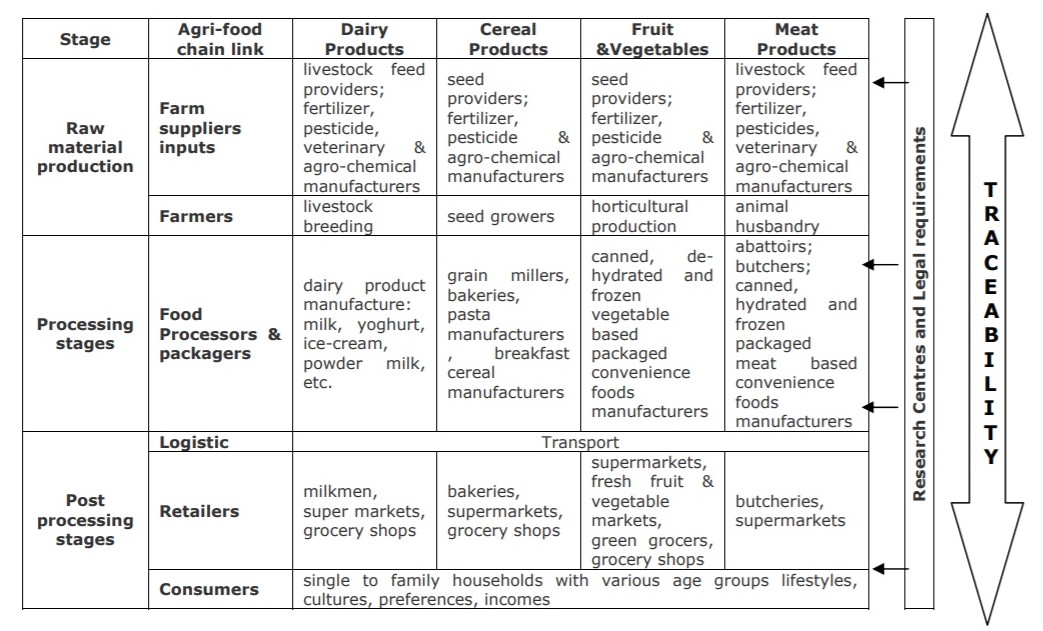
Agri-food Chain Stakeholders
Agriculture and food chains indicate a complex network of inputs and outputs that connect farm-manufacturing inputs with food consumers. Moreover, they also engage a broad range of stakeholders (Table 3). In terms of a macro-scale perspective, the main links of the chain involve “agricultural activities, food processing, distribution and consumption” (AINIA, n. d., p. 2).
Other players include feedstock suppliers, agrochemical manufacturers and suppliers, machinery and equipment manufacturers, farmers, produce marketers and sellers, food processors, suppliers of food additives, packaging suppliers, transport companies, food retailers, consumers, and waste processors. Another stakeholder is shaped by private and public research centres in the variety of subsectors of the agriculture and food sector. It is also important to note that legislative and regulatory requirements have a major impact on every link of the agri-food chain.
In-Depth Analysis of Key Stakeholders
England is considered as a leader in agricultural innovations and, thus, its government engages stakeholders from across the farming sector to investigate data-driven innovation, with a particular emphasis on open data. For instance, the key institutions, such as Department for Environment, Food & Rural Affairs (DEFRA) and the Open Data Institute (ODI) discussed data-driven innovation in agriculture together with the stakeholders in 2015. Other institutions that participated in the event were Senseye, the Center for Agriculture and Bioscience International (CABI), Farm Dog (scheduled), Agrimetrics, Agritech East, Syngenta, and the ODI. As described by Brish (2015, para. 2), the main focus was on a “distinct culture change” within the overall number of stakeholders towards increased transparency for open data. From the farmer’s perspective, integrating data into the system is highly significant as it serves as a barrier to inclusion into the data ecosystem.
It was concluded that farmers should be provided with more transparent incentives for sharing their data at short notice to help in promoting the long-term value. There are big expectations concerning the open data revolution, however, the problem is not clear enough.
Also, Defra (Department for Environment, Food and Rural Affairs) engages with a wide array of stakeholders across the United Kingdom to reflect on the future environmental policies concerning the agricultural industry. The new agriculture policy is aimed to serve as a new basis of incentives to support farmers regarding their contribution to the environment and other public goods. The Country Land and Business Association (CLA), Wildlife and Countryside Link, and Campaign to Protect Rural England (CPRE) advocate for the need of a new type of land management contract (Annex A: Stakeholder proposals, 2018). This contract should be focused on rewarding farmers for the supply of the public goods produced on their farms. It is also important to mention the discussed above political factor, such as Brexit, since departure from the European Union allows developing radically new and diverse arrangements and approaches.
Table 4. Potential stakeholders within a sector (FAO Pesticide Disposal Series, p. 311).
Many other organisations, including the National Farmers’ Union and the Green Alliance, believe that a new policy can significantly contribute to the development of innovative methods and market-based rewards for achieving the enhanced environmental outcomes. One of the organisations that follow UKAS accredited farm assurance schemes related to good agricultural practices, resource management and the environment, is LEAF Marque. There is a wide range of groups that greatly support through cooperation and provide wildlife and agriculture benefits. These involve the Wildlife Trusts, the National Park Authorities and the Areas of Outstanding Natural Beauty Partnerships, and Conservation Boards (Annex A: Stakeholder proposals, 2018).
Within a number of stakeholders are the projects, such as PINPOINT, which is The Rivers Trust partnership with Catchment Sensitive Farming, that deliver training and advice to farmers to eliminate diffuse water pollution from agriculture. By engaging stakeholders into agriculture, one may discover the most efficient ways to provide benefits for the environment at local and landscape scale.
The Farming First plan is an alliance of multi-stakeholder organisations associated with the global challenges presented at the 2009 United Nations Commission on Sustainable Development. This stakeholder coalition states that agriculture is a “fundamental approach to deal with malnutrition issue” in three critical ways (Antonaras and Kostopoulos, 2017, p. 129). As such, the first way involves biofortified foods, for instance, vitamin-A enriched rice or sweet potatoes that are grown for increased amounts of micronutrients provision of vital vitamins and minerals. The second approach implies the micronutrient-enriched fertilisers aimed at improving soil fertility and supplying more nutritious products to address micronutrient deficiencies. Finally, the stakeholder group emphasises the relevance of advanced agronomic practices that promote crop rotation and conservation tillage by stimulating food diversity and averting nutrient depletion of soils.
Even the smallest issue related to agriculture ultimately undermines a broad spectrum of consumers. The management of agricultural land and food manufacturing is a complex process, which implies that many organisations have “commercial or regulatory interests” within this sector (‘Defining the stakeholders’, n. d.). One of the essential reasons is for potential actors to control the possible health effects. As such, landowners, farmworkers, unions, farmers’ associations serve as stakeholders for farmers and their agents with interest to address the issue of victims of exposure, as well as risk management and reduction. Seed suppliers, pesticide and fertiliser manufacturers, and transport companies are stakeholders in agricultural suppliers and services. Food wholesalers and retailers, as well as transport companies, are actors within food distributors and processors. Public health institutions, food standards agencies, occupational health and safety agencies, and environmental health departments are stakeholders within national and regional health protection agencies. Other actors might include rural residents, national and local media, scientists (epidemiologists, toxicologists, environmental scientists) and many others.
By defining key stakeholders in agriculture, along with their interests, behaviours, correlations, and means to influence change, the stakeholder analysis can assist in evaluating the potential drivers and barriers of innovation. Following the ideas of Eidt, Pant and Hickey (2020, p. 5), stakeholders have the capacity to “affect change and decision-making within a particular system.” Furthermore, one can identify the possible effects of specific policy actions, as well as the wider institutional context of innovation development. In-depth stakeholder analysis helps to detect marginalised or disempowered groups and highlight the vital contribution of participatory approaches to learning, innovation, and food security to trust, collective work, and education.
Table 5. Members of ARD (agriculture and rural development) stakeholder group (Anderson, 2018).
Advice to BEA19 Technologies Ltd
The fundamental forces that may impact BEA19 entering the agriculture market involve the political, economic, and societal sectors. To be more specific, the weakening relations with the European Union, lack of skilled personnel, regulatory control over indigenous innovations, and the loss of export market shares are the challenges for the country to consider. Furthermore, the increase in R&D (research and development) expenses is noted as a positive factor; however, there is a challenge of the enhanced cyber-attacks.
The critical challenge within the agriculture sector implies balancing economic expansion with progress in the ecological status, which is complicated by the enhanced competition from emerging markets. Gupte and Longhurst (2019, p. 82) state that the strengthening of agriculture-nutrition relations through state actions “presents challenges to governments.” The analysed macro- and micro environment of agriculture provides insights into the possible opportunities and threats, as well as feasible ways to reach technological advancement within this sector.
The use of drones is an emerging approach in agricultural sector that is capable of completing a variety of tasks. This implies sprinkling pesticides, taking farm photos with GPS technology, and supplying information about water and fertiliser level. Furthermore, UAVs make valuable contribution to “defining stress in a plant” 10 days before it becomes visually apparent, which might prevent extensive crop losses (Vark, 2015, para. 4). The accurate data is pivotal to the efficient agricultural policymaking. As stated in Contributions of UK agriculture (2017, p. 26), “innovation and technological process on the part of farmers” are determining factors of the overall improvement of environmental performance. Addicott (2019, p. 217) states that the precision farming revolution resulted in new cultural practices due to “time-space compressing technologies.” This tracking device can be easily monitored manually or with the aid of on-ground IoT sensors.
This implies that emerging technologies in the agricultural sector, including UAVs system, enable farmers to farm from a distance. Farmers are now provided with more remote powers of the crops’ control. Such advancement is achieved by the engagement of satellite industries and agricultural firms. Drones can be useful for governments and development institutions since they provide more precise and up-to-date information on the farmland situation. Such technology provides current data and significantly contributes to the overall advancement of the agriculture industry.
Reference List
Addicott, J. E. (2019) The precision farming revolution: Global drivers of local agricultural methods. Bath, United Kingdom: Palgrave Macmillan.
Agriculture bill: Analysis and economic rationales for government intervention (2018) England: Department of Environment Food & Rural Affairs.
Ahtiainen, H., Pouta, E., Liski, E., Myyrä, S. and Assmuth, A. (2015) ‘Importance of economic, social, and environmental objectives of agriculture for stakeholders—a meta-analysis’, Agroecology and Sustainable Food Systems, 39(9), pp. 1047–1068.
AINIA (Association for research in the Agrifood Industry) (n.d.) Stakeholders and activities in the agri-food supply. Spain: E-Mensa.
Ali, A. (2020) ‘PESTLE analysis of UK’. Marketing Tutor. Web.
Anderson, D. (2018) ‘ARD (agriculture and rural development) stakeholder group’. Gov. (Scottish Government). Web.
Annex A: Stakeholder proposals (2018). England: Department of Environment Food & Rural Affairs.
Antonaras, A. and Kostopoulos, A. (2017) ‘Stakeholder agriculture: Innovation from farm to store’, in Tarnanidis T., Vlachopoulou M. and Papathanasiou J. (eds.) Driving agribusiness with technology innovations. Hershey: IGI Global, pp.125-147.
Brish, L. (2015) ‘Top UK agricultural stakeholders discuss how open data is transforming the industry‘. AFN. Web.
Carroll, A. B., Brown, J. and Buchholtz, A. K. (2017) Business & society: Ethics, sustainability & stakeholder management. 10th edn. Boston: Cengage Learning.
Contributions of UK agriculture: Final report (2017) England: Development Economics.
‘Defining the stakeholders: an example from agriculture’, n. d., IEHIAS. Web.
Eidt, C. M., Pant, L. P., and Hickey, G. M. (2020) ‘Platform, participation, and power: How dominant and minority stakeholders shape agricultural innovation’, Sustainability, 12 (461), pp. 1–21.
FAO Pesticide Disposal Series (n. d.) The preparation of inventories of pesticides and contaminated materials. Rome: FAO.
Future farming and environment evidence compendium (2018) England: Department of Environment Food & Rural Affairs.
Gupte, J. and Longhurst, R. (2019) ‘How do the state’s organisational capacities at the micro- and macro-levels influence agriculture-nutrition linkages in fragile contexts?’, Food Policy, 82, p. 74–83.
Hubbard, C. et al. (2019) ‘Brexit: How might UK agriculture thrive or survive? Final report’, Newcastle University, pp. 1–151.
MarketLine (2015). PESTLE country analysis report: United Kingdom. MarketLine.
Patel, M. (2018). ‘Smart farming solutions – how IoT transforms agriculture sector’. ReadWrite. Web.
Puri, V., Nayyar, A. and Raja, L. (2017). ‘Agriculture drones: a modern breakthrough in precision agriculture’, Journal of Statistics and Management Systems, 20(4), pp. 507–518.
Ramasamy, S., Semedo, M., Castro Salazar, R. and Frick, M. (2017). Tracking adaptation in agricultural sectors: Climate change adaptation Indicators. Rome: Food and Agriculture Organization of the United Nations.
Singh, A. and Jirli, B. (2018). ‘Changing perception and awareness towards ICT along with changing roles of stakeholders in agriculture’, Research Journal of Agricultural Sciences, 9(6), pp. 1412–1416.
Thompson, F. (2019) ‘Next generation farming: how drones are changing the face of British agriculture’, Deutsche Welle (DW). Web.
Turner, C. (2018) ‘Sugar tax and farming policy’, Food Matters Live. Web.
Vark, C. (2015) ‘Drones set to give global farming a makeover’. The Guardian. Web.
Appendix A
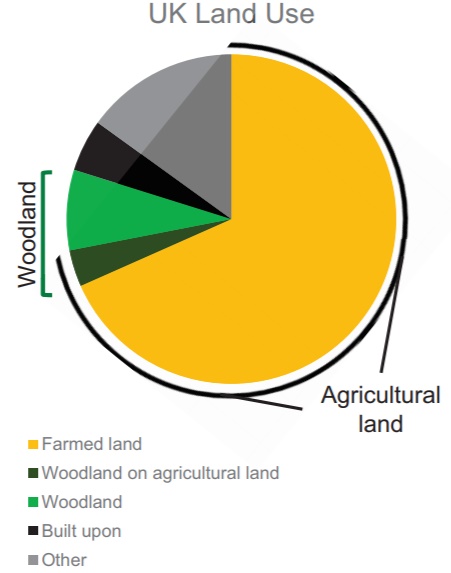
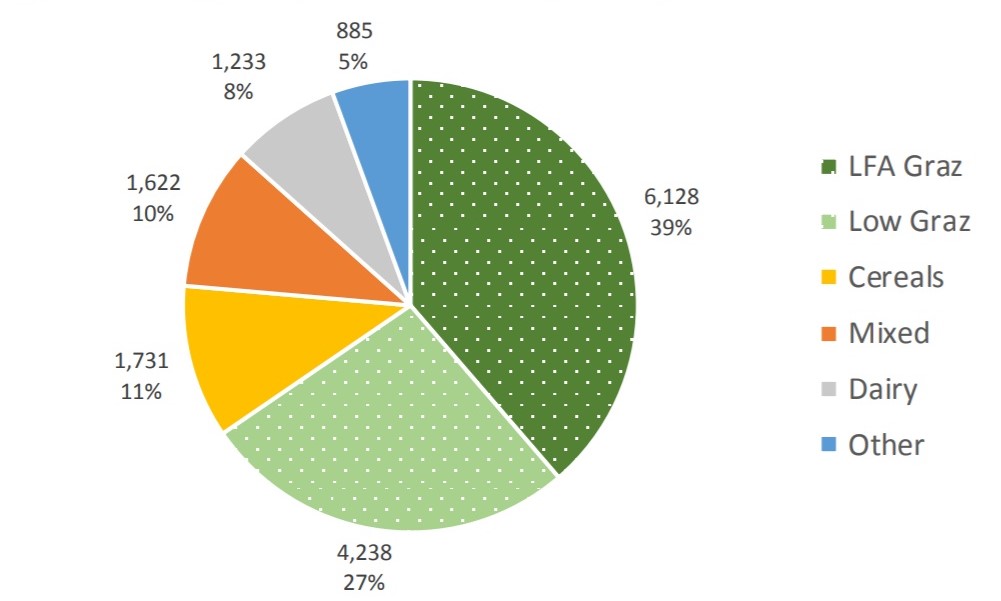
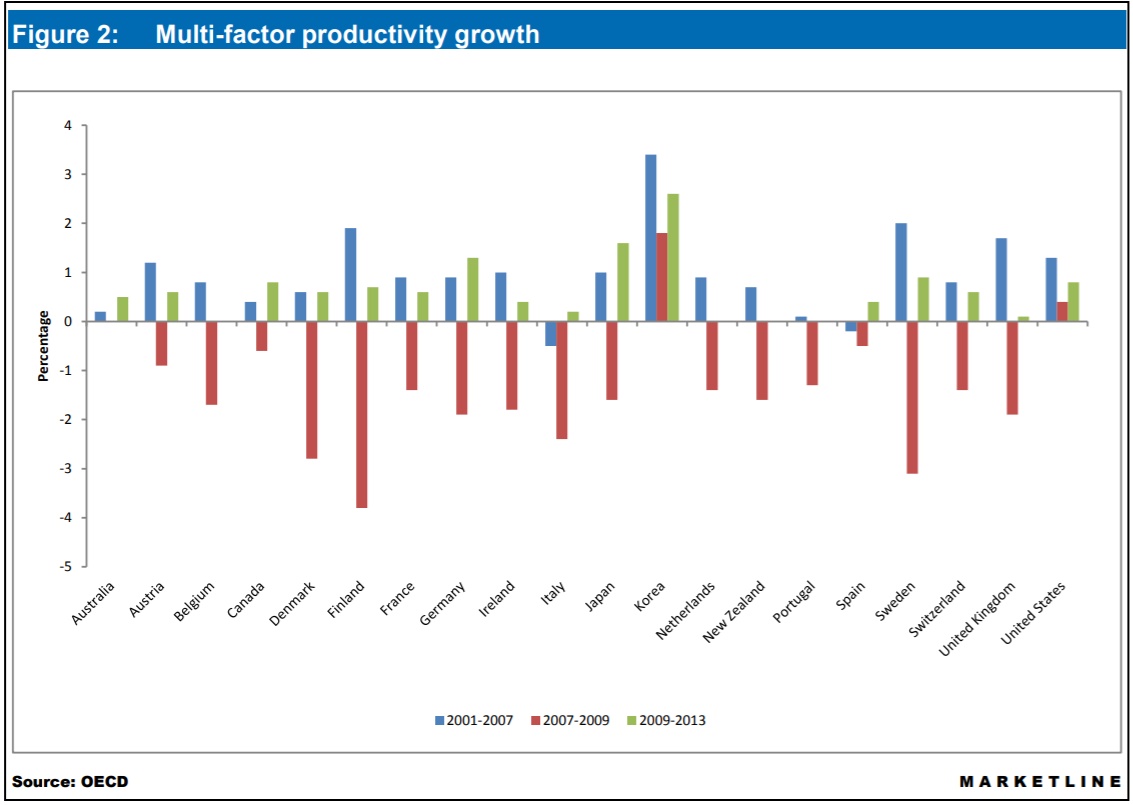
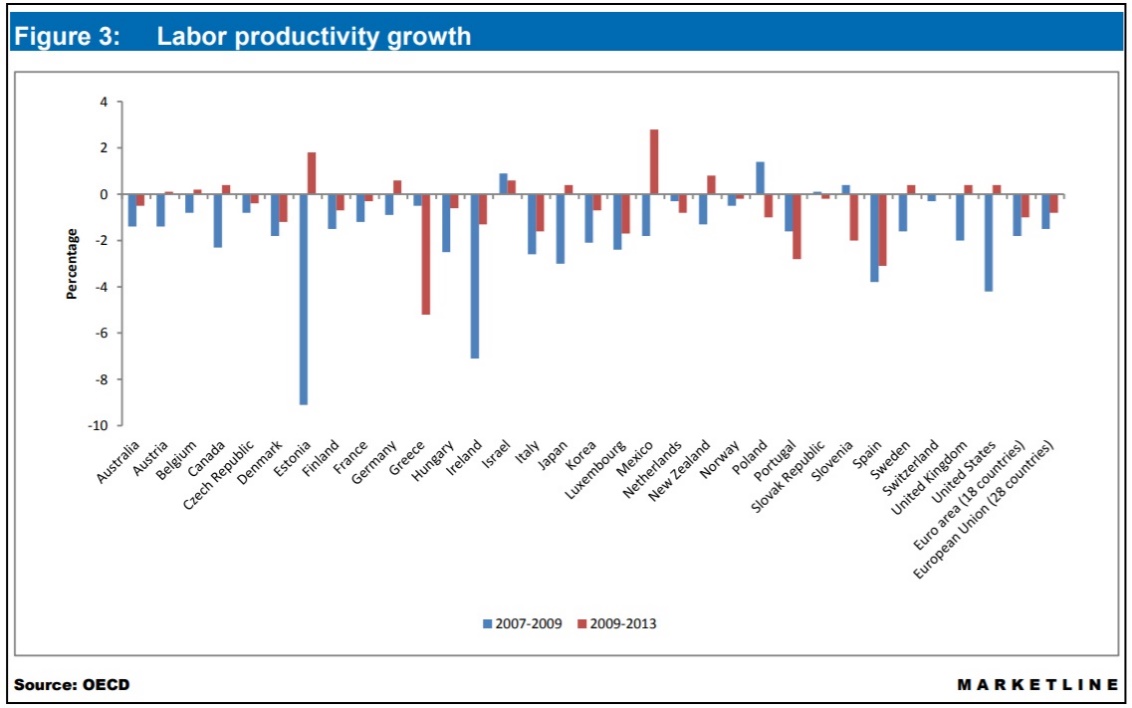
Appendix B
